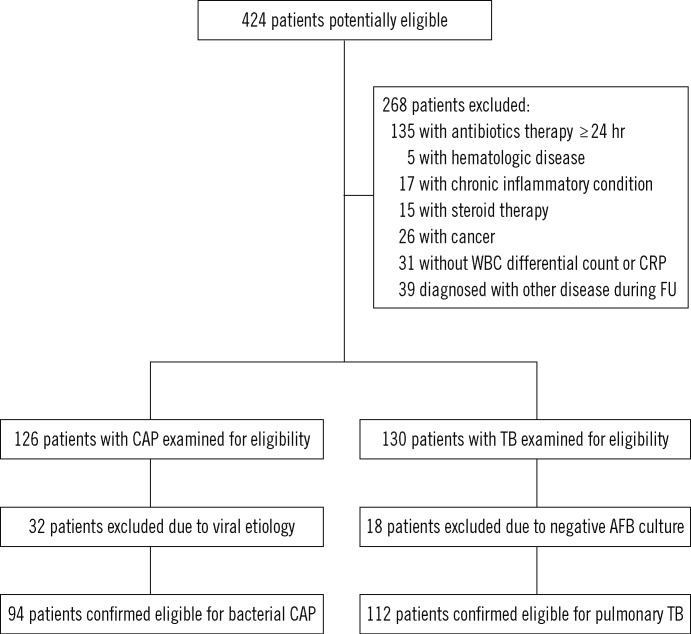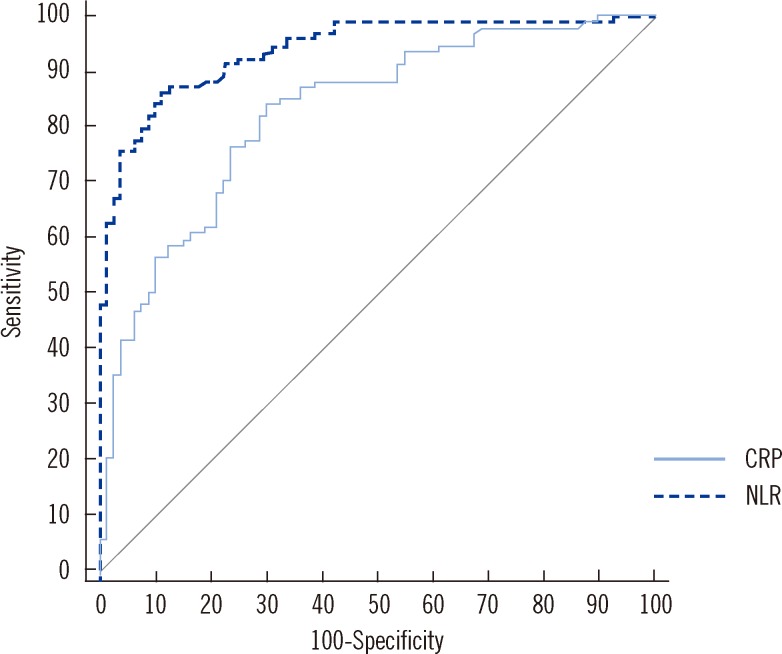Role of the Neutrophil-Lymphocyte Count Ratio in the Differential Diagnosis between Pulmonary Tuberculosis and Bacterial Community-Acquired Pneumonia
- Affiliations
-
- 1Division of Respiratory Medicine, Department of Internal Medicine, Dong-A University College of Medicine, Dong-A University Medical Center, Busan, Korea. sjum@dau.ac.kr
- KMID: 1781308
- DOI: http://doi.org/10.3343/alm.2013.33.2.105
Abstract
- BACKGROUND
Differential diagnosis between pulmonary tuberculosis (TB) and bacterial community-acquired pneumonia (CAP) is often challenging. The neutrophil-lymphocyte count ratio (NLR), a convenient marker of inflammation, has been demonstrated to be a useful biomarker for predicting bacteremia. We investigated the usefulness of the NLR for discriminating pulmonary TB from bacterial CAP in an intermediate TB-burden country.
METHODS
We retrospectively analyzed the clinical and laboratory characteristics of 206 patients suspected of having pulmonary TB or bacterial CAP from January 2009 to February 2011. The diagnostic ability of the NLR for differential diagnosis was evaluated and compared with that of C-reactive protein.
RESULTS
Serum NLR levels were significantly lower in patients with pulmonary TB than in patients with bacterial CAP (3.67+/-2.12 vs. 14.64+/-9.72, P<0.001). A NLR <7 was an optimal cut-off value to discriminate patients with pulmonary TB from patients with bacterial CAP (sensitivity 91.1%, specificity 81.9%, positive predictive value 85.7%, negative predictive value 88.5%). The area under the curve for the NLR (0.95, 95% confidence interval [CI], 0.91-0.98) was significantly greater than that of C-reactive protein (0.83, 95% CI, 0.76-0.88; P=0.0015).
CONCLUSIONS
The NLR obtained at the initial diagnostic stage is a useful laboratory marker to discriminate patients with pulmonary TB from patients with bacterial CAP in an intermediate TB-burden country.
Keyword
MeSH Terms
-
Adolescent
Adult
Aged
Aged, 80 and over
Area Under Curve
C-Reactive Protein/analysis
Community-Acquired Infections/*diagnosis
Diagnosis, Differential
Female
Humans
Leukocyte Count
Lymphocyte Count
Lymphocytes/*cytology
Male
Middle Aged
Neutrophils/*cytology
Pneumonia, Bacterial/*diagnosis
ROC Curve
Retrospective Studies
Sensitivity and Specificity
Tuberculosis, Pulmonary/*diagnosis
Young Adult
C-Reactive Protein
Figure
Cited by 3 articles
-
Are There Relationships between Seminal Parameters and the Neutrophil-to-Lymphocyte Ratio or the Platelet-to-Lymphocyte Ratio?
Serdar Aykan, Lütfi Canat, Serkan Gönültaş, Hasan Anıl Atalay, Fatih Altunrende
World J Mens Health. 2017;35(1):51-56. doi: 10.5534/wjmh.2017.35.1.51.Male Inflammatory Parameters Are not Useful to Predict the Outcomes of Intracytoplasmic Sperm Injection: Results from a Cross-Sectional Study
Gianmartin Cito, Maria Elisabetta Coccia, Rita Picone, Andrea Cocci, Giorgio Ivan Russo, Tommaso Cai, Giulia Bencini, Rossella Fucci, Elisabetta Micelli, Luciana Criscuoli, Francesco Bertocci, Elena Borrani, Sergio Serni, Marco Carini, Alessandro Natali
World J Mens Health. 2019;37(3):347-354. doi: 10.5534/wjmh.180110.Neutrophil-Lymphocyte Ratio and Monocyte-Lymphocyte Ratio According to the Radiologic Severity of
Mycobacterium avium Complex Pulmonary Disease
Mi-Ae Kim, Yea Eun Park, Yong Pil Chong, Tae Sun Shim, Kyung-Wook Jo
J Korean Med Sci. 2022;37(40):e292. doi: 10.3346/jkms.2022.37.e292.
Reference
-
1. http://www.kostat.go.kr/portal/korea/kor_ki/1/1/index.action?bmode=read&cd=S004001. Updated on Oct 2010.2. Marrie TJ. Community-acquired pneumonia. Clin Infect Dis. 1994; 18:501–513. PMID: 8038304.3. Liam CK, Pang YK, Poosparajah S. Pulmonary tuberculosis presenting as community-acquired pneumonia. Respirology. 2006; 11:786–792. PMID: 17052309.
Article4. Chan CH, Cohen M, Pang J. A prospective study of community-acquired pneumonia in Hong Kong. Chest. 1992; 101:442–446. PMID: 1735270.
Article5. Siddiqi K, Lambert ML, Walley J. Clinical diagnosis of smear-negative pulmonary tuberculosis in low-income countries: the current evidence. Lancet Infect Dis. 2003; 3:288–296. PMID: 12726978.
Article6. Ugajin M, Miwa S, Shirai M, Ohba H, Eifuku T, Nakamura H, et al. Usefulness of serum procalcitonin level in pulmonary tuberculosis. Eur Respir J. 2011; 37:371–375. PMID: 20530033.7. Kang YA, Kwon SY, Yoon HI, Lee JH, Lee CT. Role of C-reactive protein and procalcitonin in differentiation of tuberculosis from bacterial community acquired pneumonia. Korean J Intern Med. 2009; 24:337–342. PMID: 19949732.
Article8. Tintinger GR, van der Merwe JJ, Fickl H, Rheeder P, Feldman C, Anderson R. Soluble triggering receptor expressed on myeloid cells in sputum of patients with community-acquired pneumonia or pulmonary tuberculosis: a pilot study. Eur J Clin Microbiol Infect Dis. 2012; 31:73–76. PMID: 21559767.
Article9. Wyllie DH, Bowler IC, Peto TE. Relation between lymphopenia and bacteraemia in UK adults with medical emergencies. J Clin Pathol. 2004; 57:950–955. PMID: 15333656.
Article10. de Jager CP, van Wijk PT, Mathoera RB, de Jongh-Leuvenink J, van der Poll v, Wever PC. Lymphocytopenia and neutrophil-lymphocyte count ratio predict bacteremia better than conventional infection markers in an emergency care unit. Crit Care. 2010; 14:R192. PMID: 21034463.
Article11. Fine MJ, Auble TE, Yealy DM, Hanusa BH, Weissfeld LA, Singer DE, et al. A prediction rule to identify low-risk patients with community-acquired pneumonia. N Engl J Med. 1997; 336:243–250. PMID: 8995086.
Article12. WHO. Global Tuberculosis Control 2011. Updated on Oct 2011. http://www.who.int/tb/publications/global_report/2011/gtbr11_full.pdf.13. Hui KP, Chin NK, Chow K, Brownlee A, Yeo TC, Kumarasinghe G, et al. Prospective study of the aetiology of adult community acquired bacterial pneumonia needing hospitalisation in Singapore. Singapore Med J. 1993; 34:329–334. PMID: 8266206.14. Zahorec R. Ratio of neutrophil to lymphocyte counts--rapid and simple parameter of systemic inflammation and stress in critically ill. Bratisl Lek Listy. 2001; 102:5–14. PMID: 11723675.15. Goodman DA, Goodman CB, Monk JS. Use of the neutrophil: lymphocyte ratio in the diagnosis of appendicitis. Am Surg. 1995; 61:257–259. PMID: 7887542.16. Gibson PH, Croal BL, Cuthbertson BH, Small GR, Ifezulike Al, Gibson G, et al. Preoperative neutrophil-lymphocyte ratio and outcome from coronary artery bypass grafting. Am Heart J. 2007; 154:995–1002. PMID: 17967611.
Article17. Halazun KJ, Aldoori A, Malik HZ, Al-Mukhtar A, Prasad KR, Toogood GJ, et al. Elevated preoperative neutrophil to lymphocyte ratio predicts survival following hepatic resection for colorectal liver metastases. Eur J Surg Oncol. 2008; 34:55–60. PMID: 17448623.
Article18. Tamhane UU, Aneja S, Montgomery D, Rogers EK, Eagle KA, Gurm HS. Association between admission neutrophil to lymphocyte ratio and outcomes in patients with acute coronary syndrome. Am J Cardiol. 2008; 102:653–657. PMID: 18773982.
Article19. Sarraf KM, Belcher E, Raevsky E, Nicholson AG, Goldstraw P, Lim E. Neutrophil/lymphocyte ratio and its association with survival after complete resection in non-small cell lung cancer. J Thorac Cardiovasc Surg. 2009; 137:425–428. PMID: 19185164.
Article20. Rokayan SA. Serum adenosine deaminase activity and its isoenzyme in patients treated for tuberculosis. J Coll Physicians Surg Pak. 2003; 13:11–14. PMID: 12685967.21. Burgess LJ, Maritz FJ, Irene Le Roux I, Taljaard JJ. Combined use of pleural adenosine deaminase with lymphocyte/neutrophil ratio. Increased specificity for the diagnosis of tuberculous pleuritis. Chest. 1996; 109:414–419. PMID: 8620715.22. Charles PG, Whitby M, Fuller AJ, Stirling R, Wright AA, Korman TM, et al. The etiology of community-acquired pneumonia in Australia: why penicillin plus doxycycline or a macrolide is the most appropriate therapy. Clin Infect Dis. 2008; 46:1513–1521. PMID: 18419484.
Article23. Song JH, Oh WS, Kang CI, Chung DR, Peck KR, Ko KS, et al. Epidemiology and clinical outcomes of community-acquired pneumonia in adult patients in Asian countries: a prospective study by the Asian network for surveillance of resistant pathogens. Int J Antimicrob Agents. 2008; 31:107–114. PMID: 18162378.
Article
- Full Text Links
- Actions
-
Cited
- CITED
-
- Close
- Share
- Similar articles
-
- A Case of Pulmonary Tuberculosis with Delayed Diagnosis Due to the Temporary Clinical Improvement After Use of Levofloxacin and Amikacin Under the Impression of Community Acquired Pneumonia
- Role of C-Reactive Protein and Procalcitonin in Differentiation of Tuberculosis from Bacterial Community Acquired Pneumonia
- Measurement of Nitric Oxide in the Differential Diagnosis of Lymphocytic Pleural Effusion
- Respiratory Review of 2010: Pneumonia
- Treatment Guidelines for Community-acquired Pneumonia in Korea: An Evidence-based Approach to Appropriate Antimicrobial Therapy



